E-commerce Market in Australia: Customer Influence Analysis
VerifiedAdded on 2022/12/15
|21
|5111
|464
Report
AI Summary
This report provides an in-depth analysis of the e-commerce market in Australia, focusing on the attributes that influence customer behavior in online shopping. The study utilizes secondary data, exploring factors such as social media platforms, customer demographics (gender, age, and education), and the impact of various online shopping habits. The findings highlight the positive and negative influences of social platforms on e-commerce businesses, along with key issues faced by customers, including trust, data security, accessibility, and perceived quality. The report also examines the role of government in shaping the e-commerce landscape. The research employs frequency data analysis to interpret the data from a data archive. The report concludes with recommendations for addressing the identified challenges and fostering the growth of the e-commerce industry in Australia, considering the evolving trends and customer preferences. The report also provides a detailed literature review and research methodology, including data collection and analysis techniques, with a focus on the Australian market.

E-commerce market in Australia-
attributes influencing customers
i
attributes influencing customers
i
Paraphrase This Document
Need a fresh take? Get an instant paraphrase of this document with our AI Paraphraser

Executive summary
The main aim of this study was to determine the attributes influencing the customers towards
their engagement in online shopping and the issues faced by customers on online shopping. Data
used by the researcher was secondary and was obtained from data.world. Frequency data
analysis was employed in the exploration and analysis of data. From the study, the findings
indicated that social platforms imposed both good and bad influence on e-commerce businesses.
Furthermore, issues identified that were faced by the customers in the journey of online shopping
were trust, data security, awareness, accessibility, perceived quality and the role government. It
was then concluded and recommended that such issues affecting ecommerce needed to be
addressed adequately for the development of ecommerce industry.
ii
The main aim of this study was to determine the attributes influencing the customers towards
their engagement in online shopping and the issues faced by customers on online shopping. Data
used by the researcher was secondary and was obtained from data.world. Frequency data
analysis was employed in the exploration and analysis of data. From the study, the findings
indicated that social platforms imposed both good and bad influence on e-commerce businesses.
Furthermore, issues identified that were faced by the customers in the journey of online shopping
were trust, data security, awareness, accessibility, perceived quality and the role government. It
was then concluded and recommended that such issues affecting ecommerce needed to be
addressed adequately for the development of ecommerce industry.
ii
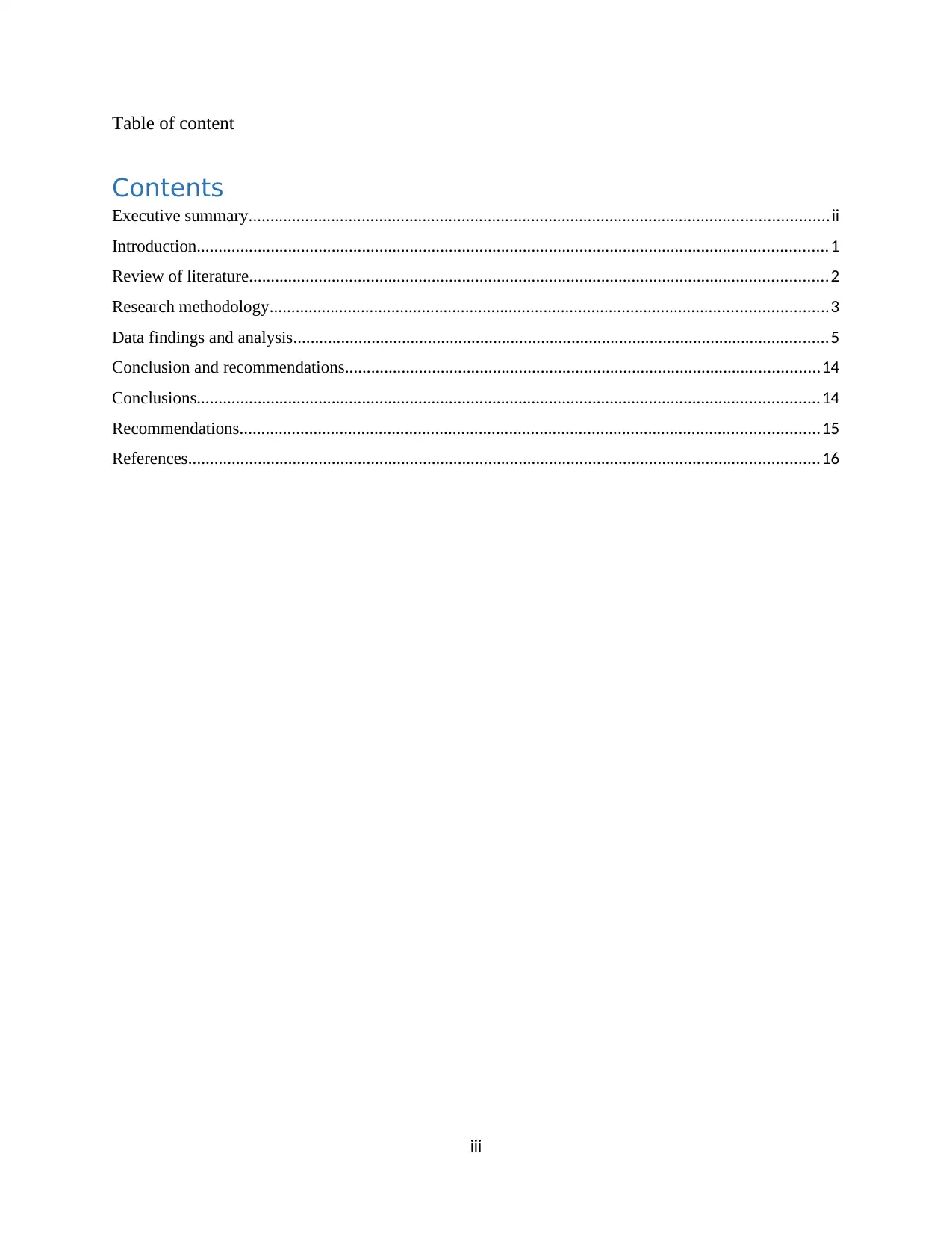
Table of content
Contents
Executive summary.....................................................................................................................................ii
Introduction.................................................................................................................................................1
Review of literature.....................................................................................................................................2
Research methodology................................................................................................................................3
Data findings and analysis...........................................................................................................................5
Conclusion and recommendations.............................................................................................................14
Conclusions...............................................................................................................................................14
Recommendations.....................................................................................................................................15
References.................................................................................................................................................16
iii
Contents
Executive summary.....................................................................................................................................ii
Introduction.................................................................................................................................................1
Review of literature.....................................................................................................................................2
Research methodology................................................................................................................................3
Data findings and analysis...........................................................................................................................5
Conclusion and recommendations.............................................................................................................14
Conclusions...............................................................................................................................................14
Recommendations.....................................................................................................................................15
References.................................................................................................................................................16
iii
⊘ This is a preview!⊘
Do you want full access?
Subscribe today to unlock all pages.

Trusted by 1+ million students worldwide
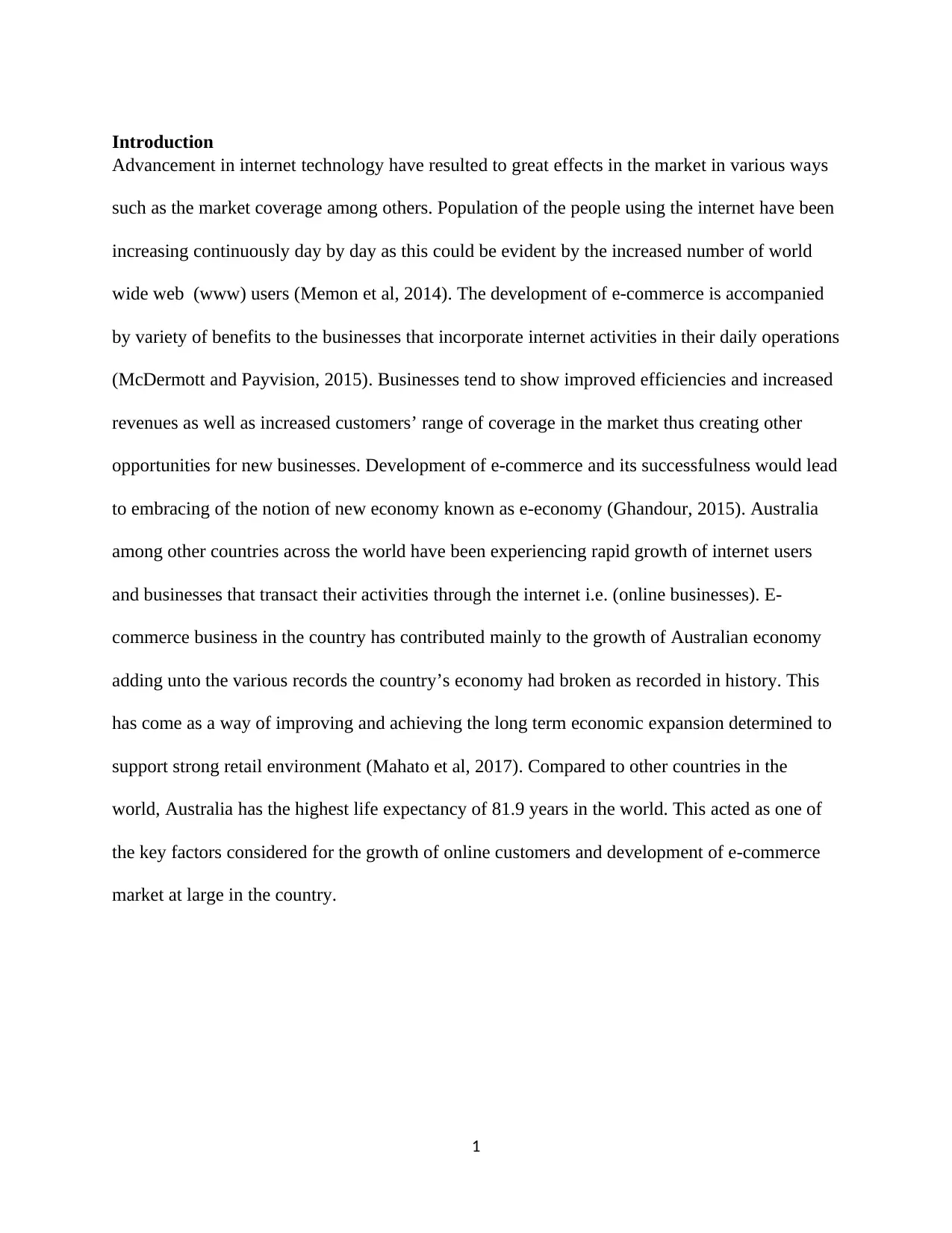
Introduction
Advancement in internet technology have resulted to great effects in the market in various ways
such as the market coverage among others. Population of the people using the internet have been
increasing continuously day by day as this could be evident by the increased number of world
wide web (www) users (Memon et al, 2014). The development of e-commerce is accompanied
by variety of benefits to the businesses that incorporate internet activities in their daily operations
(McDermott and Payvision, 2015). Businesses tend to show improved efficiencies and increased
revenues as well as increased customers’ range of coverage in the market thus creating other
opportunities for new businesses. Development of e-commerce and its successfulness would lead
to embracing of the notion of new economy known as e-economy (Ghandour, 2015). Australia
among other countries across the world have been experiencing rapid growth of internet users
and businesses that transact their activities through the internet i.e. (online businesses). E-
commerce business in the country has contributed mainly to the growth of Australian economy
adding unto the various records the country’s economy had broken as recorded in history. This
has come as a way of improving and achieving the long term economic expansion determined to
support strong retail environment (Mahato et al, 2017). Compared to other countries in the
world, Australia has the highest life expectancy of 81.9 years in the world. This acted as one of
the key factors considered for the growth of online customers and development of e-commerce
market at large in the country.
1
Advancement in internet technology have resulted to great effects in the market in various ways
such as the market coverage among others. Population of the people using the internet have been
increasing continuously day by day as this could be evident by the increased number of world
wide web (www) users (Memon et al, 2014). The development of e-commerce is accompanied
by variety of benefits to the businesses that incorporate internet activities in their daily operations
(McDermott and Payvision, 2015). Businesses tend to show improved efficiencies and increased
revenues as well as increased customers’ range of coverage in the market thus creating other
opportunities for new businesses. Development of e-commerce and its successfulness would lead
to embracing of the notion of new economy known as e-economy (Ghandour, 2015). Australia
among other countries across the world have been experiencing rapid growth of internet users
and businesses that transact their activities through the internet i.e. (online businesses). E-
commerce business in the country has contributed mainly to the growth of Australian economy
adding unto the various records the country’s economy had broken as recorded in history. This
has come as a way of improving and achieving the long term economic expansion determined to
support strong retail environment (Mahato et al, 2017). Compared to other countries in the
world, Australia has the highest life expectancy of 81.9 years in the world. This acted as one of
the key factors considered for the growth of online customers and development of e-commerce
market at large in the country.
1
Paraphrase This Document
Need a fresh take? Get an instant paraphrase of this document with our AI Paraphraser
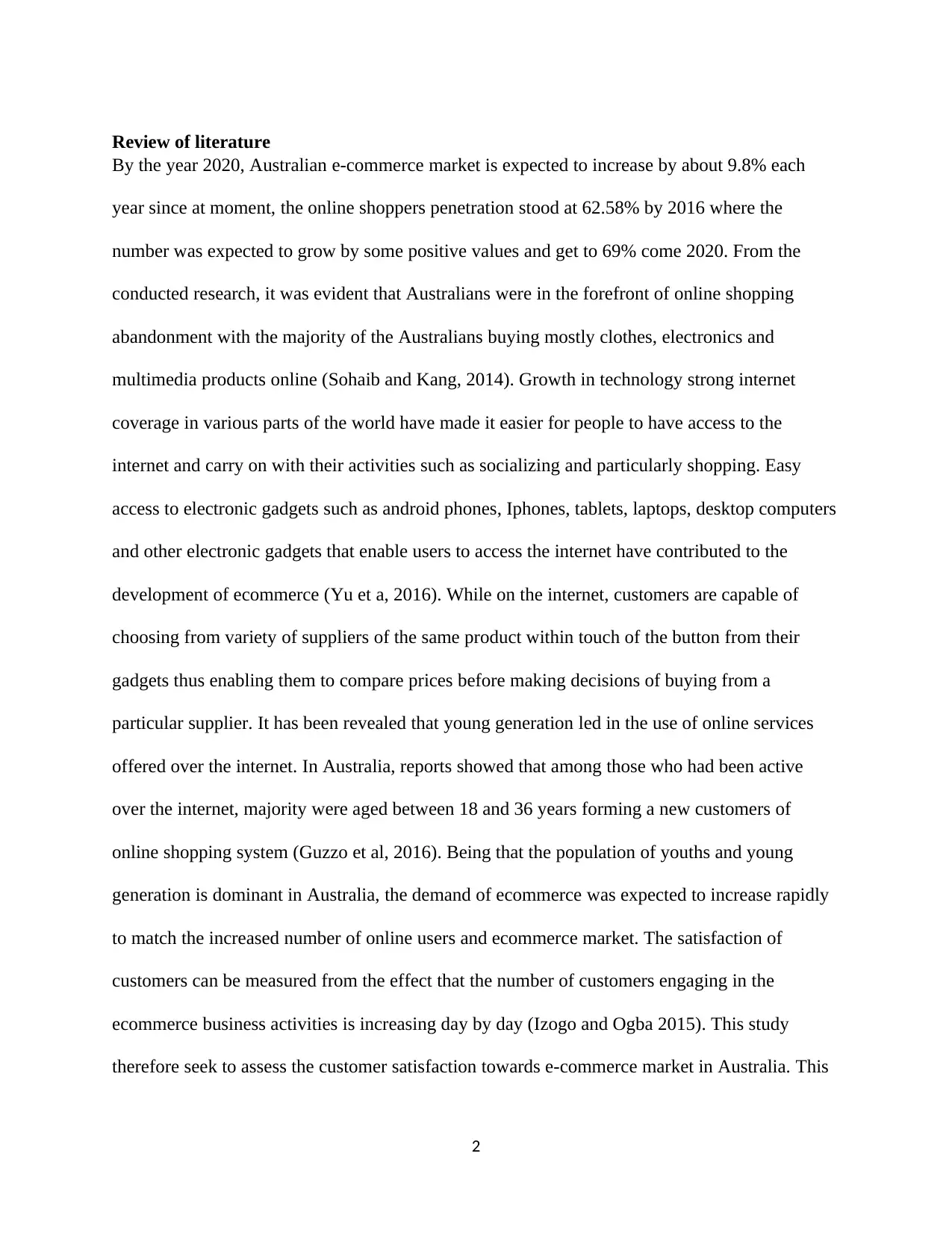
Review of literature
By the year 2020, Australian e-commerce market is expected to increase by about 9.8% each
year since at moment, the online shoppers penetration stood at 62.58% by 2016 where the
number was expected to grow by some positive values and get to 69% come 2020. From the
conducted research, it was evident that Australians were in the forefront of online shopping
abandonment with the majority of the Australians buying mostly clothes, electronics and
multimedia products online (Sohaib and Kang, 2014). Growth in technology strong internet
coverage in various parts of the world have made it easier for people to have access to the
internet and carry on with their activities such as socializing and particularly shopping. Easy
access to electronic gadgets such as android phones, Iphones, tablets, laptops, desktop computers
and other electronic gadgets that enable users to access the internet have contributed to the
development of ecommerce (Yu et a, 2016). While on the internet, customers are capable of
choosing from variety of suppliers of the same product within touch of the button from their
gadgets thus enabling them to compare prices before making decisions of buying from a
particular supplier. It has been revealed that young generation led in the use of online services
offered over the internet. In Australia, reports showed that among those who had been active
over the internet, majority were aged between 18 and 36 years forming a new customers of
online shopping system (Guzzo et al, 2016). Being that the population of youths and young
generation is dominant in Australia, the demand of ecommerce was expected to increase rapidly
to match the increased number of online users and ecommerce market. The satisfaction of
customers can be measured from the effect that the number of customers engaging in the
ecommerce business activities is increasing day by day (Izogo and Ogba 2015). This study
therefore seek to assess the customer satisfaction towards e-commerce market in Australia. This
2
By the year 2020, Australian e-commerce market is expected to increase by about 9.8% each
year since at moment, the online shoppers penetration stood at 62.58% by 2016 where the
number was expected to grow by some positive values and get to 69% come 2020. From the
conducted research, it was evident that Australians were in the forefront of online shopping
abandonment with the majority of the Australians buying mostly clothes, electronics and
multimedia products online (Sohaib and Kang, 2014). Growth in technology strong internet
coverage in various parts of the world have made it easier for people to have access to the
internet and carry on with their activities such as socializing and particularly shopping. Easy
access to electronic gadgets such as android phones, Iphones, tablets, laptops, desktop computers
and other electronic gadgets that enable users to access the internet have contributed to the
development of ecommerce (Yu et a, 2016). While on the internet, customers are capable of
choosing from variety of suppliers of the same product within touch of the button from their
gadgets thus enabling them to compare prices before making decisions of buying from a
particular supplier. It has been revealed that young generation led in the use of online services
offered over the internet. In Australia, reports showed that among those who had been active
over the internet, majority were aged between 18 and 36 years forming a new customers of
online shopping system (Guzzo et al, 2016). Being that the population of youths and young
generation is dominant in Australia, the demand of ecommerce was expected to increase rapidly
to match the increased number of online users and ecommerce market. The satisfaction of
customers can be measured from the effect that the number of customers engaging in the
ecommerce business activities is increasing day by day (Izogo and Ogba 2015). This study
therefore seek to assess the customer satisfaction towards e-commerce market in Australia. This
2

was checked considering both business to business transaction through the internet and business
to customers or customers to businesses through the internet too.
Research methodology
Secondary data was collected by the researcher and was used in the analysis to find the results
that supported the study. Secondary data is the already existing data that have been collected by
other people/ researchers and are readily available for use by others from other sources (Ellram
and Tate, 2016). Such data are in most cases preferred because they are economical thus save
time, efforts and expenses since they are only retrieved from the archival source. Furthermore,
according to (Dunn et al, 2015), secondary data was preferred because of its nature of assisting in
improving the problem understanding and giving the basis for comparison of the data collected
by the researcher on a particular subject matter. For the collected secondary data to hold, the data
needs to be updated (Carroll et al, 2017) and in that case the researcher collected data on the
ecommerce that covered from the year 2015 to date on the consumer satisfaction and what
influenced their use of online for shopping. The collected secondary data comprised of the
following data items in the data file, segment type, social platform, count (continuous),
percentage, level of customers’ satisfaction and their influence experience with 1450 number of
cases. The data was collected from data archive data.world.
The retrieved data were in excel file where they were further organized and analyzed using the
SPSS statistical software. The software was used in the manipulation of data and generation of
tables and figures which were copied and pasted to support the study. Qualitative and
quantitative data analysis approaches will be employed by the researcher to fully leverage the
data. Frequency statistics was used to represent data in tables and figures for depiction and easy
interpretation of the data. Data will as well be explored using descriptive statistics to find some
3
to customers or customers to businesses through the internet too.
Research methodology
Secondary data was collected by the researcher and was used in the analysis to find the results
that supported the study. Secondary data is the already existing data that have been collected by
other people/ researchers and are readily available for use by others from other sources (Ellram
and Tate, 2016). Such data are in most cases preferred because they are economical thus save
time, efforts and expenses since they are only retrieved from the archival source. Furthermore,
according to (Dunn et al, 2015), secondary data was preferred because of its nature of assisting in
improving the problem understanding and giving the basis for comparison of the data collected
by the researcher on a particular subject matter. For the collected secondary data to hold, the data
needs to be updated (Carroll et al, 2017) and in that case the researcher collected data on the
ecommerce that covered from the year 2015 to date on the consumer satisfaction and what
influenced their use of online for shopping. The collected secondary data comprised of the
following data items in the data file, segment type, social platform, count (continuous),
percentage, level of customers’ satisfaction and their influence experience with 1450 number of
cases. The data was collected from data archive data.world.
The retrieved data were in excel file where they were further organized and analyzed using the
SPSS statistical software. The software was used in the manipulation of data and generation of
tables and figures which were copied and pasted to support the study. Qualitative and
quantitative data analysis approaches will be employed by the researcher to fully leverage the
data. Frequency statistics was used to represent data in tables and figures for depiction and easy
interpretation of the data. Data will as well be explored using descriptive statistics to find some
3
⊘ This is a preview!⊘
Do you want full access?
Subscribe today to unlock all pages.

Trusted by 1+ million students worldwide

insights from the data and to leave nothing to chance. Small and medium business enterprises
will all benefit from the results drawn from data since they would be able to see the trends of the
ecommerce phenomena which would enable them to predict the future occurrences of the
business. The business operators would also benefit in that they would be able to draw decisions
that would enhance the growth and development of ecommerce industry. Growth and stability of
ecommerce forms basis for firm country’s economic growth.
4
will all benefit from the results drawn from data since they would be able to see the trends of the
ecommerce phenomena which would enable them to predict the future occurrences of the
business. The business operators would also benefit in that they would be able to draw decisions
that would enhance the growth and development of ecommerce industry. Growth and stability of
ecommerce forms basis for firm country’s economic growth.
4
Paraphrase This Document
Need a fresh take? Get an instant paraphrase of this document with our AI Paraphraser
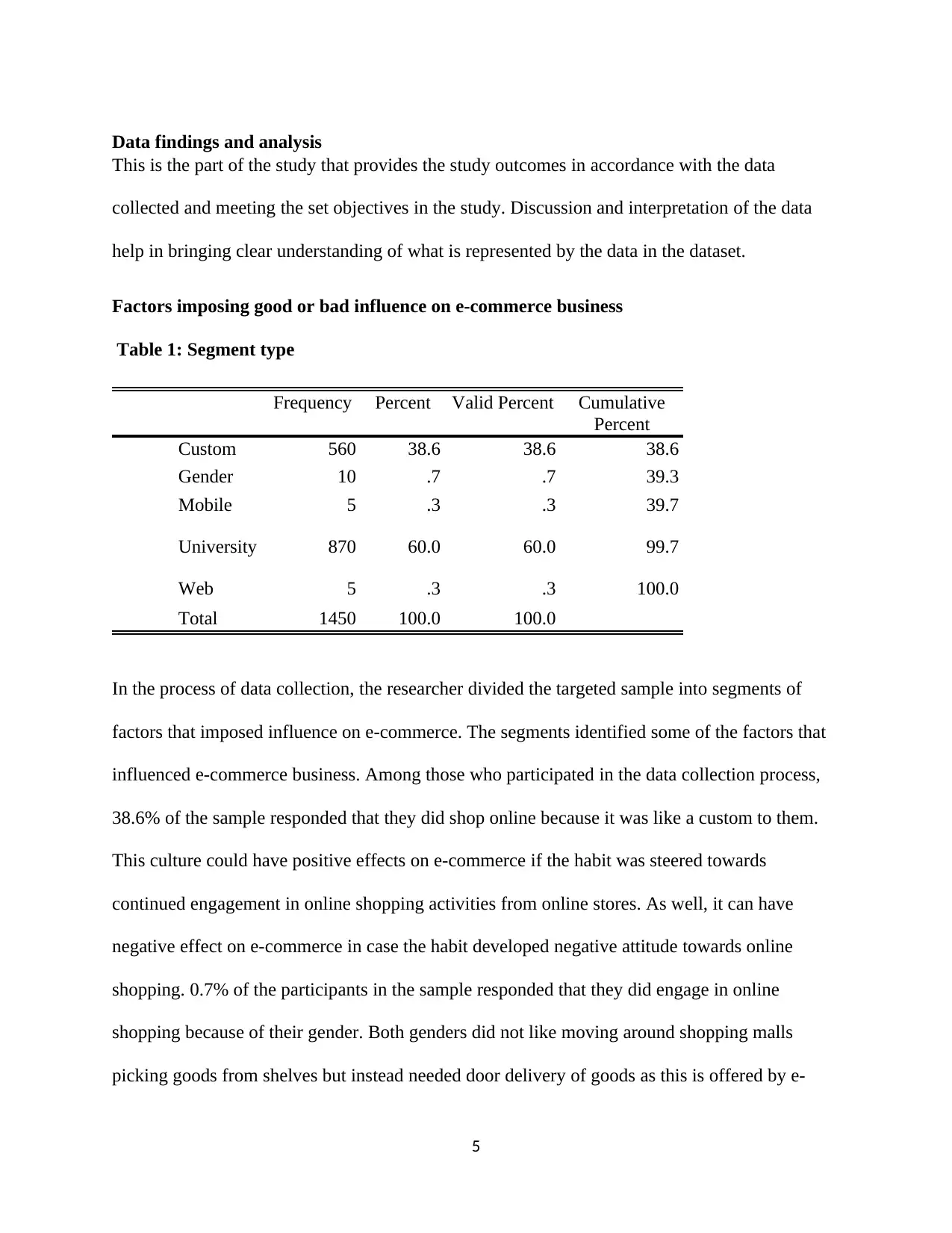
Data findings and analysis
This is the part of the study that provides the study outcomes in accordance with the data
collected and meeting the set objectives in the study. Discussion and interpretation of the data
help in bringing clear understanding of what is represented by the data in the dataset.
Factors imposing good or bad influence on e-commerce business
Table 1: Segment type
Frequency Percent Valid Percent Cumulative
Percent
Custom 560 38.6 38.6 38.6
Gender 10 .7 .7 39.3
Mobile 5 .3 .3 39.7
University 870 60.0 60.0 99.7
Web 5 .3 .3 100.0
Total 1450 100.0 100.0
In the process of data collection, the researcher divided the targeted sample into segments of
factors that imposed influence on e-commerce. The segments identified some of the factors that
influenced e-commerce business. Among those who participated in the data collection process,
38.6% of the sample responded that they did shop online because it was like a custom to them.
This culture could have positive effects on e-commerce if the habit was steered towards
continued engagement in online shopping activities from online stores. As well, it can have
negative effect on e-commerce in case the habit developed negative attitude towards online
shopping. 0.7% of the participants in the sample responded that they did engage in online
shopping because of their gender. Both genders did not like moving around shopping malls
picking goods from shelves but instead needed door delivery of goods as this is offered by e-
5
This is the part of the study that provides the study outcomes in accordance with the data
collected and meeting the set objectives in the study. Discussion and interpretation of the data
help in bringing clear understanding of what is represented by the data in the dataset.
Factors imposing good or bad influence on e-commerce business
Table 1: Segment type
Frequency Percent Valid Percent Cumulative
Percent
Custom 560 38.6 38.6 38.6
Gender 10 .7 .7 39.3
Mobile 5 .3 .3 39.7
University 870 60.0 60.0 99.7
Web 5 .3 .3 100.0
Total 1450 100.0 100.0
In the process of data collection, the researcher divided the targeted sample into segments of
factors that imposed influence on e-commerce. The segments identified some of the factors that
influenced e-commerce business. Among those who participated in the data collection process,
38.6% of the sample responded that they did shop online because it was like a custom to them.
This culture could have positive effects on e-commerce if the habit was steered towards
continued engagement in online shopping activities from online stores. As well, it can have
negative effect on e-commerce in case the habit developed negative attitude towards online
shopping. 0.7% of the participants in the sample responded that they did engage in online
shopping because of their gender. Both genders did not like moving around shopping malls
picking goods from shelves but instead needed door delivery of goods as this is offered by e-
5

commerce businesses. 0.3% responded that they did engage in online shopping because of the
mobility nature of the business (online shops), this imposed positive effect on the e-commerce
since customers could easily access them from anywhere at any time. 60% of the respondents in
the sample responded that they did engage in online shopping activity because they were
students at the university and finally. Learning institutions enlighten students of the benefits of
engaging and transforming to e-commerce businesses where the majority of the learners try out
the idea by shopping online which is a plus to the e-commerce industry. 0.3% of the participants
responded that they did engage in online shopping because of their addiction to the web. Web
had played a major role in ensuring the development of e-commerce and reaching out to every
individual capable of accessing the websites. From the responses, various people engaged in
online shopping due to variety of factors out of which majority of them had been represented in
the segments. A good number of people had developed the habit of shopping online instead of
shopping from stores which influenced e-commerce positively. This habit have helped in
development of ecommerce industry since as they keep shopping from online stores, they were
also building the ecommerce industry. Nature of the activities people engage in in their daily
lives and tight schedules they had all day also took a center stage of key factors affecting
shopping online as majority of the online shoppers were at universities taking their studies. The
segmentation of the respondents were also as represented in the figure below:
6
mobility nature of the business (online shops), this imposed positive effect on the e-commerce
since customers could easily access them from anywhere at any time. 60% of the respondents in
the sample responded that they did engage in online shopping activity because they were
students at the university and finally. Learning institutions enlighten students of the benefits of
engaging and transforming to e-commerce businesses where the majority of the learners try out
the idea by shopping online which is a plus to the e-commerce industry. 0.3% of the participants
responded that they did engage in online shopping because of their addiction to the web. Web
had played a major role in ensuring the development of e-commerce and reaching out to every
individual capable of accessing the websites. From the responses, various people engaged in
online shopping due to variety of factors out of which majority of them had been represented in
the segments. A good number of people had developed the habit of shopping online instead of
shopping from stores which influenced e-commerce positively. This habit have helped in
development of ecommerce industry since as they keep shopping from online stores, they were
also building the ecommerce industry. Nature of the activities people engage in in their daily
lives and tight schedules they had all day also took a center stage of key factors affecting
shopping online as majority of the online shoppers were at universities taking their studies. The
segmentation of the respondents were also as represented in the figure below:
6
⊘ This is a preview!⊘
Do you want full access?
Subscribe today to unlock all pages.

Trusted by 1+ million students worldwide
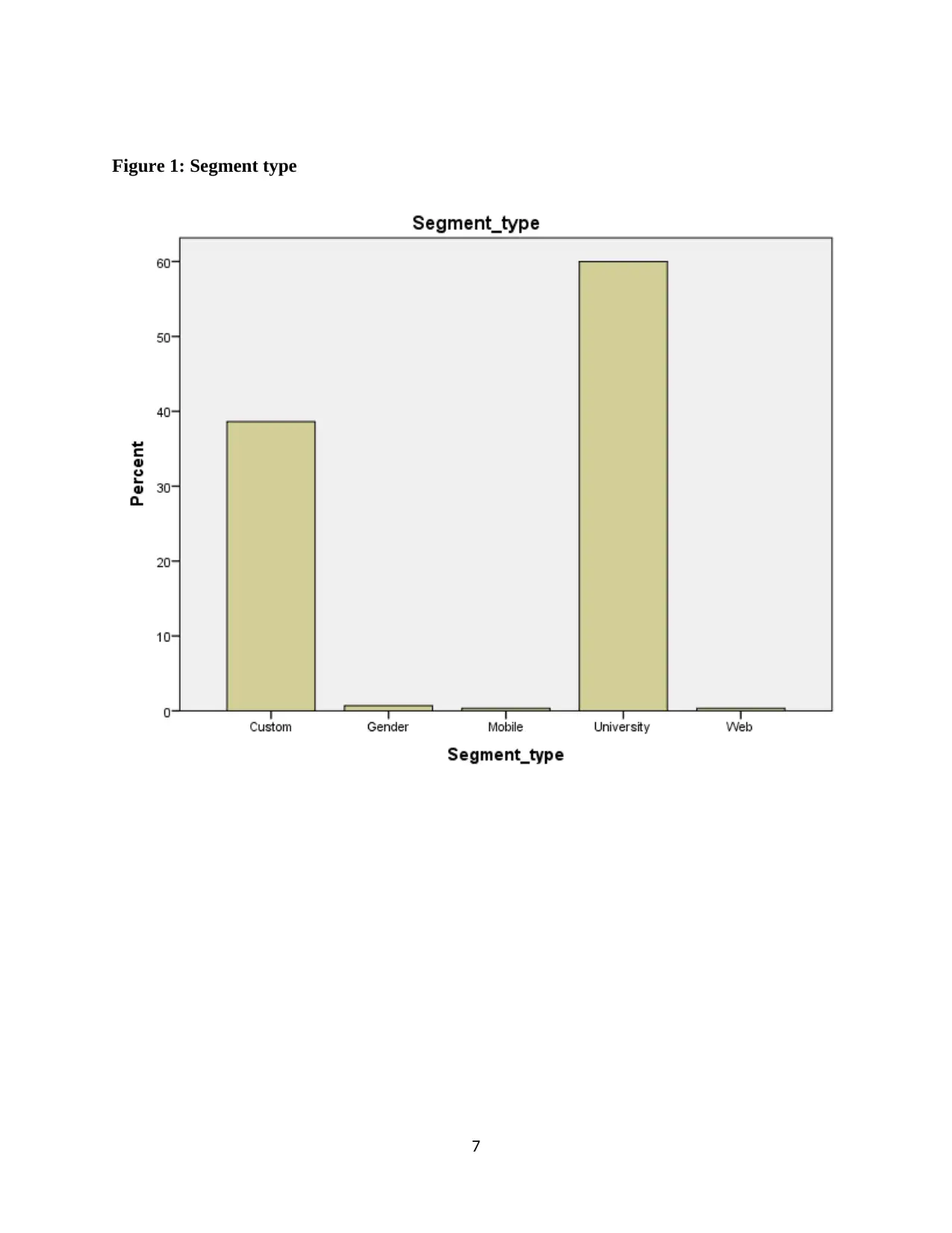
Figure 1: Segment type
7
7
Paraphrase This Document
Need a fresh take? Get an instant paraphrase of this document with our AI Paraphraser
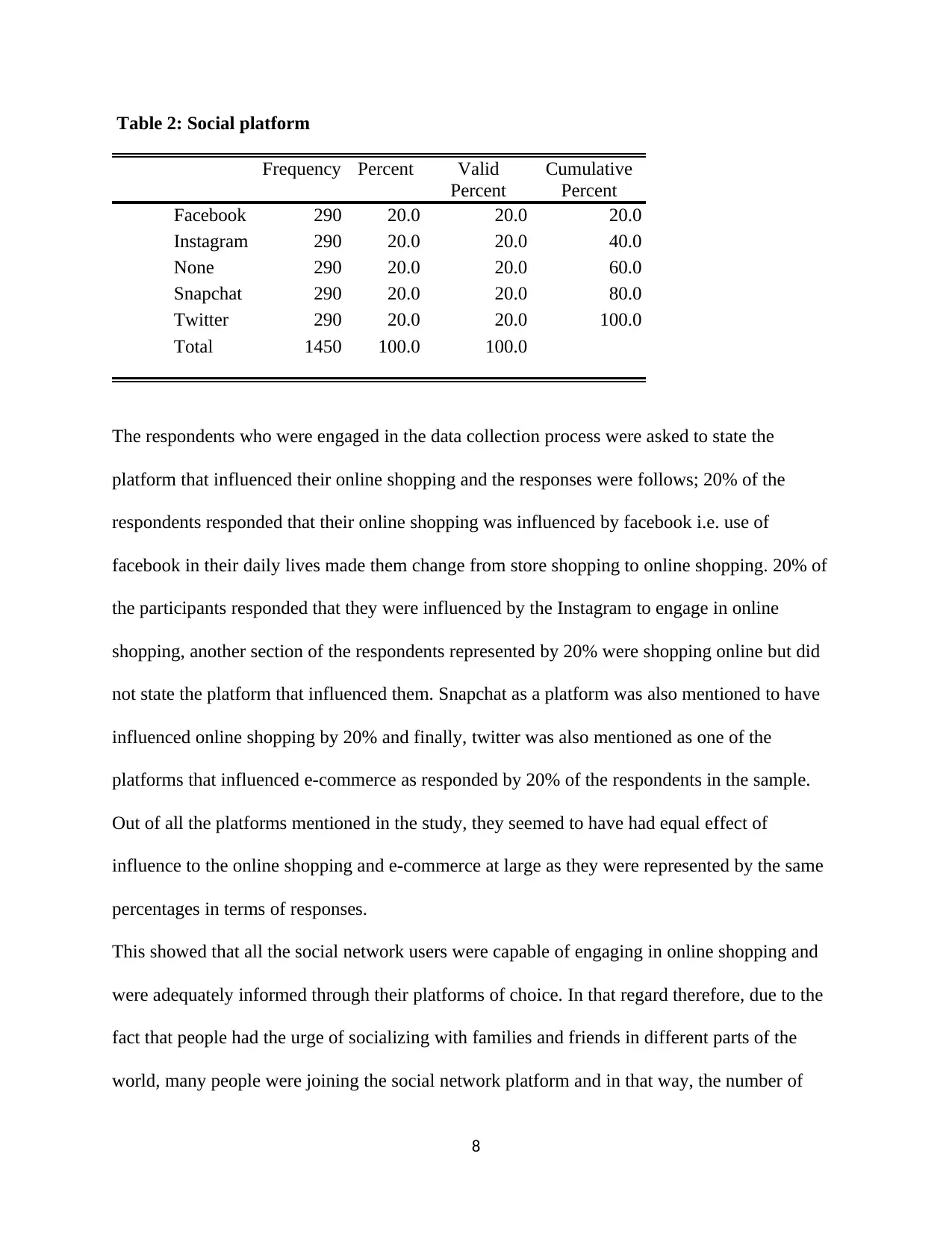
Table 2: Social platform
Frequency Percent Valid
Percent
Cumulative
Percent
Facebook 290 20.0 20.0 20.0
Instagram 290 20.0 20.0 40.0
None 290 20.0 20.0 60.0
Snapchat 290 20.0 20.0 80.0
Twitter 290 20.0 20.0 100.0
Total 1450 100.0 100.0
The respondents who were engaged in the data collection process were asked to state the
platform that influenced their online shopping and the responses were follows; 20% of the
respondents responded that their online shopping was influenced by facebook i.e. use of
facebook in their daily lives made them change from store shopping to online shopping. 20% of
the participants responded that they were influenced by the Instagram to engage in online
shopping, another section of the respondents represented by 20% were shopping online but did
not state the platform that influenced them. Snapchat as a platform was also mentioned to have
influenced online shopping by 20% and finally, twitter was also mentioned as one of the
platforms that influenced e-commerce as responded by 20% of the respondents in the sample.
Out of all the platforms mentioned in the study, they seemed to have had equal effect of
influence to the online shopping and e-commerce at large as they were represented by the same
percentages in terms of responses.
This showed that all the social network users were capable of engaging in online shopping and
were adequately informed through their platforms of choice. In that regard therefore, due to the
fact that people had the urge of socializing with families and friends in different parts of the
world, many people were joining the social network platform and in that way, the number of
8
Frequency Percent Valid
Percent
Cumulative
Percent
Facebook 290 20.0 20.0 20.0
Instagram 290 20.0 20.0 40.0
None 290 20.0 20.0 60.0
Snapchat 290 20.0 20.0 80.0
Twitter 290 20.0 20.0 100.0
Total 1450 100.0 100.0
The respondents who were engaged in the data collection process were asked to state the
platform that influenced their online shopping and the responses were follows; 20% of the
respondents responded that their online shopping was influenced by facebook i.e. use of
facebook in their daily lives made them change from store shopping to online shopping. 20% of
the participants responded that they were influenced by the Instagram to engage in online
shopping, another section of the respondents represented by 20% were shopping online but did
not state the platform that influenced them. Snapchat as a platform was also mentioned to have
influenced online shopping by 20% and finally, twitter was also mentioned as one of the
platforms that influenced e-commerce as responded by 20% of the respondents in the sample.
Out of all the platforms mentioned in the study, they seemed to have had equal effect of
influence to the online shopping and e-commerce at large as they were represented by the same
percentages in terms of responses.
This showed that all the social network users were capable of engaging in online shopping and
were adequately informed through their platforms of choice. In that regard therefore, due to the
fact that people had the urge of socializing with families and friends in different parts of the
world, many people were joining the social network platform and in that way, the number of
8
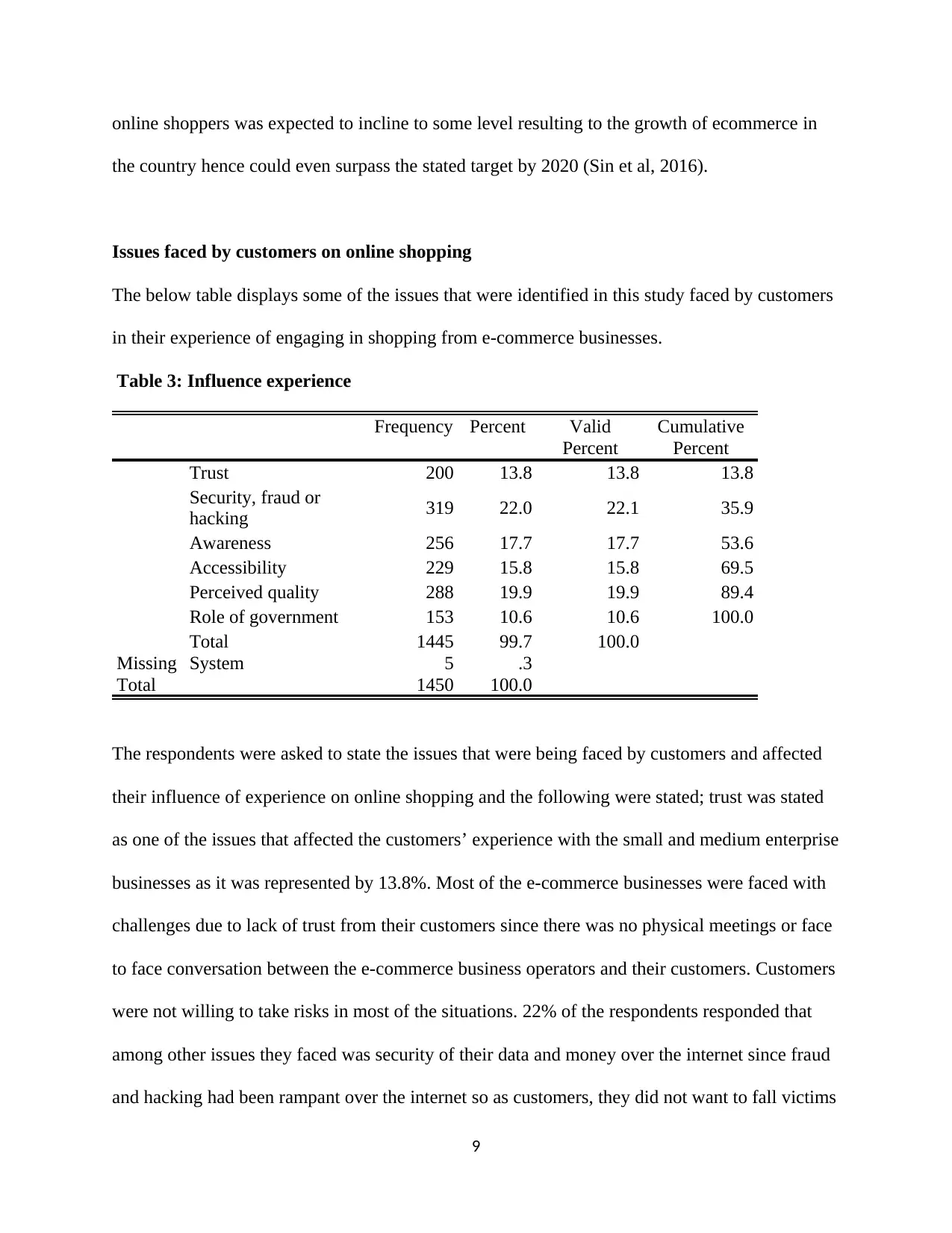
online shoppers was expected to incline to some level resulting to the growth of ecommerce in
the country hence could even surpass the stated target by 2020 (Sin et al, 2016).
Issues faced by customers on online shopping
The below table displays some of the issues that were identified in this study faced by customers
in their experience of engaging in shopping from e-commerce businesses.
Table 3: Influence experience
Frequency Percent Valid
Percent
Cumulative
Percent
Trust 200 13.8 13.8 13.8
Security, fraud or
hacking 319 22.0 22.1 35.9
Awareness 256 17.7 17.7 53.6
Accessibility 229 15.8 15.8 69.5
Perceived quality 288 19.9 19.9 89.4
Role of government 153 10.6 10.6 100.0
Total 1445 99.7 100.0
Missing System 5 .3
Total 1450 100.0
The respondents were asked to state the issues that were being faced by customers and affected
their influence of experience on online shopping and the following were stated; trust was stated
as one of the issues that affected the customers’ experience with the small and medium enterprise
businesses as it was represented by 13.8%. Most of the e-commerce businesses were faced with
challenges due to lack of trust from their customers since there was no physical meetings or face
to face conversation between the e-commerce business operators and their customers. Customers
were not willing to take risks in most of the situations. 22% of the respondents responded that
among other issues they faced was security of their data and money over the internet since fraud
and hacking had been rampant over the internet so as customers, they did not want to fall victims
9
the country hence could even surpass the stated target by 2020 (Sin et al, 2016).
Issues faced by customers on online shopping
The below table displays some of the issues that were identified in this study faced by customers
in their experience of engaging in shopping from e-commerce businesses.
Table 3: Influence experience
Frequency Percent Valid
Percent
Cumulative
Percent
Trust 200 13.8 13.8 13.8
Security, fraud or
hacking 319 22.0 22.1 35.9
Awareness 256 17.7 17.7 53.6
Accessibility 229 15.8 15.8 69.5
Perceived quality 288 19.9 19.9 89.4
Role of government 153 10.6 10.6 100.0
Total 1445 99.7 100.0
Missing System 5 .3
Total 1450 100.0
The respondents were asked to state the issues that were being faced by customers and affected
their influence of experience on online shopping and the following were stated; trust was stated
as one of the issues that affected the customers’ experience with the small and medium enterprise
businesses as it was represented by 13.8%. Most of the e-commerce businesses were faced with
challenges due to lack of trust from their customers since there was no physical meetings or face
to face conversation between the e-commerce business operators and their customers. Customers
were not willing to take risks in most of the situations. 22% of the respondents responded that
among other issues they faced was security of their data and money over the internet since fraud
and hacking had been rampant over the internet so as customers, they did not want to fall victims
9
⊘ This is a preview!⊘
Do you want full access?
Subscribe today to unlock all pages.

Trusted by 1+ million students worldwide
1 out of 21
Related Documents
Your All-in-One AI-Powered Toolkit for Academic Success.
+13062052269
info@desklib.com
Available 24*7 on WhatsApp / Email
![[object Object]](/_next/static/media/star-bottom.7253800d.svg)
Unlock your academic potential
Copyright © 2020–2025 A2Z Services. All Rights Reserved. Developed and managed by ZUCOL.




